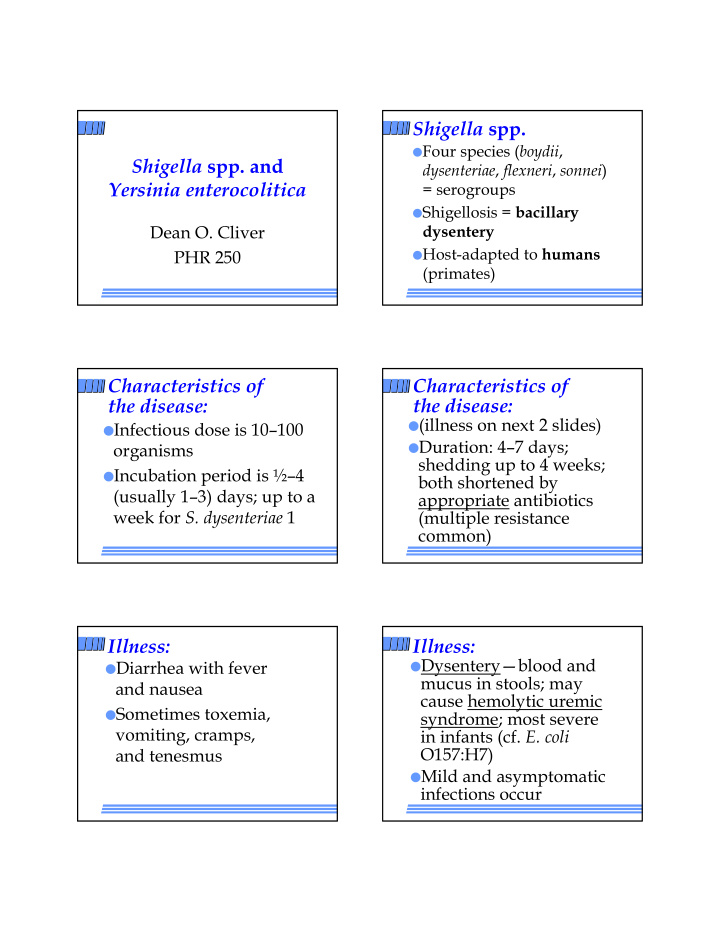



Shigella spp. � Four species ( boydii , Shigella spp. and dysenteriae , flexneri , sonnei ) Yersinia enterocolitica = serogroups � Shigellosis = bacillary Dean O. Cliver dysentery � Host-adapted to humans PHR 250 (primates) Characteristics of Characteristics of the disease: the disease: � (illness on next 2 slides) � Infectious dose is 10–100 � Duration: 4–7 days; organisms shedding up to 4 weeks; � Incubation period is ½–4 both shortened by (usually 1–3) days; up to a appropriate antibiotics week for S. dysenteriae 1 (multiple resistance common) Illness: Illness: � Dysentery—blood and � Diarrhea with fever mucus in stools; may and nausea cause hemolytic uremic � Sometimes toxemia, syndrome; most severe vomiting, cramps, in infants (cf. E. coli O157:H7) and tenesmus � Mild and asymptomatic infections occur
Characteristics of Characteristics of the organism the organism � Nonmotile, nonsporing, � Temperature range for gram-negative short rods; growth (strain-dependent) close genetic relationship to E. coli 7–46 E C, optimum 37 E C � Invades the colonic � pH range for growth 5–8, epithelium; many strains acetic acid stops growth produce shigatoxin or shiga-like toxin at pH 6 Transmission via food: Transmission via food: � CDC estimates ~90,000 cases � Fourth-ranked cause of foodborne disease in U.S., per year, 14 deaths 1998–2002 (~735/yr), as � FoodNet (2005) ≈ 14,000 reported by CDC cases � CAST estimates 90,000– � Survives well in neutral-pH 163,000 cases per year, foods, poorly in acid foods, # 180 deaths, $390 average may grow (e.g., in cost/case watermelon) Transmission via food: Isolation & identification: � Food at 4 E C or frozen if held � Vehicles may be anything contaminated with infectious >24 hr human feces: � Enrichment broths and � water (2 outbreaks in U.S., selective media fairly typical 1994) for gram-negative bacteria � baked goods, fruits and � Usually lactose-negative; vegetables, chicken, many other biochemical tests hamburger, potato salad, finfish implicated in apply outbreaks
Treatment, prevention, Isolation & identification: summary � Species identification is largely serological. � Treatment with antibiotics � “Molecular” detection, (resistance) typing and subtyping � Prevention ≈ sanitation methods are available. Treatment, prevention, YERSINIA summary ENTEROCOLITICA � Yersinia spun off from � Shigella is widespread, Pasteurella potentially deadly; shed � Includes Y. pestis (cause of in human feces. plague) � Frequent transmission via � Y. enterocolitica is principal food indicates frequent foodborne species; reservoir in swine sanitation failure. Characteristics of Characteristics of disease: disease: � Incubation usually 3–7 days, � May mimic acute generally <10 days appendicitis � Acute febrile diarrhea � Postinfectious arthritis in adolescents and young � Enterocolitis adults
Characteristics of Characteristics of organism: organism: � Gram-negative, � Growth range of nonsporeforming rods; temperatures is -2–42 E C, facultatively anaerobic; optimum 28–29 E C motile by peritrichous � In raw pork at 7 E C, has grown to 10 9 –10 10 cells/g flagella (only at temperatures # 35 E C) within 10 days Characteristics of Transmission via food: organism: � CDC: 8 outbreaks (87 cases), � pH range for growth is 4.2– 1998–2002 9.0, with an optimum of 7–8 � CAST report: 3,250–20,000 � Grows in the presence of cases/yr (1 death?); $5,450 5% but not >7% NaCl per case � Virulence is plasmid- dependent and is limited to a few serotypes Transmission via food: Transmission via food: � Y. enterocolitica isolated from � CDC estimates ~87,000 foods other than pork foodborne cases/year, appears to be avirulent for 2 deaths humans � FoodNet (2005) ~1,080 � Transmission via water & dairy products; tofu packed in spring water
Isolation & Isolation & identification: identification: � Enrichment culture � Samples held at 4 E C if sometimes treated with possible 0.5% KOH for 15 sec before � Cold enrichment: PBS; plating—kills many 4 E C for 2–4 weeks (or competing organisms 10 E C, 3 days; 15 E C, 2 � Selective media—use # 32 E C days?) Treatment & prevention Summary � Should be prevented by � Treated with antibiotics careful handling & cooking other than penicillin and its of pork & avoiding cross- derivatives. contamination of other � Foodborne yersiniosis is a foods; however, milk and highly specialized problem dairy products have also involving transmission from been vehicles. swine.
Recommend
More recommend